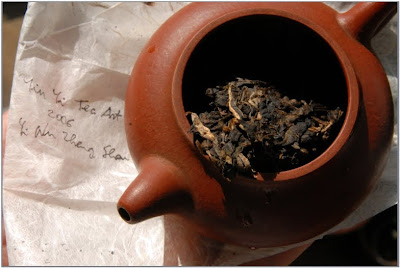

Sharing our tea every day


 This is a tea it has been expired over a half year. A quite unique tea which called shinmatcha, composing the name of the first presentation tea in Japan (shincha) and the matcha. While in matcha producing process is indispensable to "age" the tea to obtain mellow taste almost for a half of year, manufacture a first matcha immediately after the harvest is a very special method and only few producers can grant it. Publish this post right now is obviously too early, we have more than one month to this season shincha and shinmatcha and we wish for all tea lovers a god tea season, not as last year. So why now and what is this tea out of season? This is a shinmatcha Gin (silver level) of Marukyu Koyamaen from 2009, best before date is 12.09.2009. This is one of the last tins remained and we taste it curiously, how the last year expired tea is finished.
This is a tea it has been expired over a half year. A quite unique tea which called shinmatcha, composing the name of the first presentation tea in Japan (shincha) and the matcha. While in matcha producing process is indispensable to "age" the tea to obtain mellow taste almost for a half of year, manufacture a first matcha immediately after the harvest is a very special method and only few producers can grant it. Publish this post right now is obviously too early, we have more than one month to this season shincha and shinmatcha and we wish for all tea lovers a god tea season, not as last year. So why now and what is this tea out of season? This is a shinmatcha Gin (silver level) of Marukyu Koyamaen from 2009, best before date is 12.09.2009. This is one of the last tins remained and we taste it curiously, how the last year expired tea is finished.



 Ez a tea több, mint egy éve lejárt. Egészen különleges lényről van szó, shinmatchának hívjuk, aminek neve a szezon első szedésű és elsőnek, bemutatkozásként elkészített tea nevéből (shincha) és a matcha, a porrá őrölt zöld tea nevéből áll össze. Mivel a porrá őrölt zöld tea, illetve általában minden árnyékolt zöld tea gyártásához elengedhetetlena tea érlelése, ami a matcha alapteája esetében legalább 6 hónap, ehhez hasonló első matcha termelése igazán különleges dolog és csak kevés gyártó vállalkozik rá. Shinmatchát bemutatni egy áprilisi cikkben nyilvánvalóan korai, még legalább egy hónapunk van addig, amíg megérkezik a 2010-es shincha és shinmatcha, kívánunk minden tea kedvelőnek a tavalyinál szebb szezont.
Ez a tea több, mint egy éve lejárt. Egészen különleges lényről van szó, shinmatchának hívjuk, aminek neve a szezon első szedésű és elsőnek, bemutatkozásként elkészített tea nevéből (shincha) és a matcha, a porrá őrölt zöld tea nevéből áll össze. Mivel a porrá őrölt zöld tea, illetve általában minden árnyékolt zöld tea gyártásához elengedhetetlena tea érlelése, ami a matcha alapteája esetében legalább 6 hónap, ehhez hasonló első matcha termelése igazán különleges dolog és csak kevés gyártó vállalkozik rá. Shinmatchát bemutatni egy áprilisi cikkben nyilvánvalóan korai, még legalább egy hónapunk van addig, amíg megérkezik a 2010-es shincha és shinmatcha, kívánunk minden tea kedvelőnek a tavalyinál szebb szezont.
Qiqiang 旗 枪 flags and spears is the name of this the tea category on the time scale of the development of the new tea buds. One not opened bud contained another tip inside and one open, fresh leaf. Very short time to pick it, and an early, very fresh tea. As time scale we can call it also Mingqian (明前) tea, because picked before Qing Ming (Clear Brightness) in early April.
This tea is quite unique and symbolize the ambition of the new chinese tea and development of the last decade. The intention is to produce very mild, fruity, sweet green which is also rich in taste, but smell and mildness seems to be more important.
This is a pre-season Long Jing tea outside the famed XiHu - West Lake, but more expensive as the real one. There are several second rank terroirs producing Long Jing and some of them has the advantage to begin the crop much earlier as the traditional Long Jing plantages. First crop in this regions is simultaneous with early march biluochun type, "not open bud" teas from Sichuan. The meaning of this tea is the same of the japanese shincha, the first tea. The plantage offers a first fresh tea after the long march winter and would like also present how this year will be. To be the first signifies a cost relatively high, this pre season teas are 2 times expensive as a high quality, but regular crop Xi Hu tea. The secondary pre season terroirs are Qian Tang, He Shan, Xin Chang, Yuezhou etc.., all in the same province, Zhejiang.
In green tea preparing there are several ways, but for this early crop teas is obligatory to use mild, pure 70 Co water, with very cautious pouring. This tea is very fragrant with fruity and floral smell, denote suspiciously green, light green colour, all this reveal that total poliphenol and amino acid content is unusual high. If you observe this photo you can see the red lines over the shape of the leaves. This means tea is very rich and strong and despite the mindful and expert handmade firing process, the leaves began to the fermentation. It is not necessary to taste it. Enough to watch and you know you will feel in your mouth a delicious tea beauty, a fine liquor with extremly strong cha qi.
Magyarul mindez részletesen itt olvasható.





